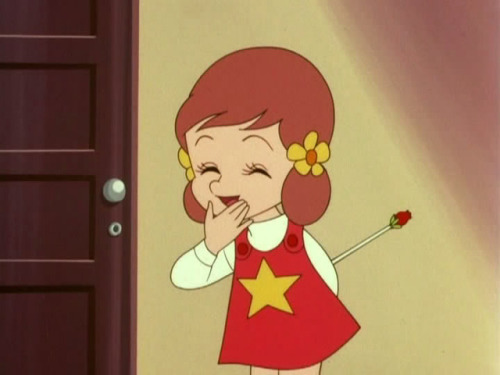1972 saw some of the more significant anime works that impacted the Japanese toy industry, fan culture, and children’s education, particularly from a foreign perspective. Around this time, Channel 8’s (Fuji Television Network) was starting to screen the "Calpis Animation Theatre" slot that introduced anime shows based on foreign children’s’ literature. The Calpis Animation Theater was renamed several times depending on its sponsors, such as the "Kids’ Animation Theatre", and the "House Animation Theater", but generally the shows of the series are known as the "Theater for World Literature", in which Isao Takahata and Hayao Miyazaki participated with Heidi, Girl of the Alps and Marco.
During the same time period that Mokku of the Oak Tree (Kashi no Ki Mokku), a retelling of the piece of children's literature, Pinocchio, was aired from January to December, Moomin (ムーミン) was broadcast in the Calpis Animation Theatre block. (The 1972 series was actually called "New Moomin", as the original ran in 1969 and 1970. - Ed.) This story was based on author Tove Jansson’s children’s literature of the same name, in which the vivid lives of the fairy tribe called Moomin in the Moomin Valley were depicted. The protagonist, Moomin, was played by Kyôko Kishida, a famous actress with considerably unique voice, but the cute looking characterizations of Moomin and his friends with huge round eyes were so far from the original illustrations that Jansson expressed her strong discomfort to this work. However, this distinguished work immediately gained much popularity among Japanese children.
Two important manga works from one of the most prominent boys’ manga artists, Go Nagai, were adopted into anime this year: Devil Man (デビルマン from July 1972 to April 1973) and Mazinger Z, a.k.a. Tranzor Z (マジンガーZ from December 1972 to September 1974). Although conventional anime narrative has the binary opposition (good and evil) and ends up with a triumph of the good, Devil Man challenges this convention by featuring the protagonist who betrays the demon tribe and possesses a high school boy, Akira Fudo, and fights with his tribe to protect his love, Miki.
On the other hand, Mazinger Z is the first of a long string of serialized super robot anime works in the mecha genre. It features an unintelligent but brave high school boy, Koji Kabuto, who is suddenly designated to become the pilot of the huge robot, Mazinger Z, to save the earth because his grandfather who produced it was assassinated by Dr. Hell’s Robot Team. This impacted audiences in and outside Japan. A great contribution of this anime is its merchandized toy “Super-Alloy Z” which became the first successful case of “character goods” industry.
Science Ninja Team Gatchaman (Kagaku Ninjatai Gatchaman, 科学忍者隊ガッチャマン), a.k.a. Battle of the Planets or G-Force, also started in this year. This is Tatsunoko Pro’s first team-oriented superhero anime. Employed by Dr. Nanbu, the head of the international science organization, the protagonists, Ken, Jo, Junpei, Ryu and the only female member, Jun, fight with the villain, Galactor, the terrorist organization. They transform themselves into Gatchaman with the powers of "Science Ninpô", the combination of technology and supernatural ninja power, and finally destroy Galactor’s plan to control the earth. With the American superhero narrative and transformation, this superhero team with one female member format was followed by super-sentai series of Toei’s suit action hero drama that started in 1975.
While you may have heard of these shows, there are others you may not have...
Chappie the Witch (Mahô Tsukai Chappii, 魔法使いチャッピー) also started in April and lasted until December. This is the fifth work in the mahô-shôjo ("magical girl") genre in Japan. Chappie, the Western-oriented witch, comes down to the human world and solves problems that arise among friends. Besides Chappie, her lesser panda friend, Don-chan, also became popular among girl audiences during the “Panda Boom” triggered by the panda bears coming to Ueno Zoo from China after the 1972 diplomatic normalization between Japan and China.
Gutsy Frog (Dokonjô Gaeru from October 1972 to September 1974) was a popular gag anime, depicting the everyday lives of ordinary people in the small-town Nerima section of Tokyo. One day, a high school boy, Hiroshi, comes across a stone that fell onto a frog. The flat frog, Pyonkichi, gets stuck on his T-shirt and suddenly speaks to him one day. Since then, strange friendship between Hiroshi and Pyonkichi begins, involving people in the neighborhood.
Moonlight Mask (Gekkô Kamen) was aired under the official title "The One Who Loves Justice: Moonlight Mask" from January to October. Moonlight Mask was the first suited-hero action drama for Japanese kids that originally aired in 1958 as an ode to The Lone Ranger, its hero covering himself with white clothes and a white mask with the huge Moon-shaped badge on his forehead. (Does he look familiar to you, Sailor Moon fans? - Ed.)
Finally, one of the budô martial arts (kenjutsu) manga classics Akado Suzunosuke (赤胴鈴之助) was adopted into an anime aired between April 1972 and March 1973. In the Edo period, Suzunosuke Kaneno becomes an apprentice of Shusaku Chiba, the master of Hokushin Itto School and grew up to be a full-fledged swordsman.The original manga title from 1954 was called Yowamushi Suzunosuke ("Crybaby Suzunosuke"), but by the time Isao Takahata got to it in 1972, the title had been changed to "Redbreast Suzunosuke" (for his breastplate) during its run as a radio drama. It may not look like it, but animation was led by Hayao Miyazaki, one of a long line of shows before his TV directorial debut in 1978.
Next Time: Well, what do you know? It's 1978! How's that for timing?



No comments:
Post a Comment